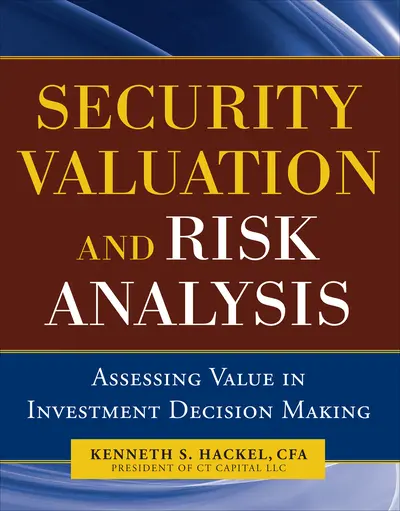My Account Details

ISBN10: 0071744355 | ISBN13: 9780071744355

Step 1 . Download Adobe Digital Editions to your PC or Mac desktop/laptop.
Step 2. Register and authorize your Adobe ID (optional). To access your eBook on multiple devices, first create an Adobe ID at account.adobe.com. Then, open Adobe Digital Editions, go to the Help menu, and select "Authorize Computer" to link your Adobe ID.
Step 3. Open Your eBook. Use Adobe Digital Editions to open the file. If the eBook doesn’t open, contact customer service for assistance.
A superior new replacement to traditional discounted cash flow valuation models Executives and corporate finance practitioners now have a more reliable discount rate to value companies and make important business and investment decisions. In today's market, it’s free cash flow, cost of capital and return on invested capital that really matters, and now there's a superior tool to help analyze these metrics—Security Valuation and Risk Analysis. In this pioneering book, valuation authority Kenneth Hackel presents his next-generation methodology for placing a confident value on an enterprise and identifying discrepancies in value—a system that will provide even themost well-informed investor with an important competitive advantage. At the core of Security Valuation and Risk Analysis is Hackel's successful credit model fordetermining an accurate fair value and reliable discount rate for a company. Using free cash flow as the basis for evaluating return on invested capital is the most effective method for determining value. Hackel takes you step by step through years of compelling evidence thatshows how his method has earned outsized returns and helped turn around companies that were heading toward failure. Whether used for corporate portfolio strategy,acquisitions, or performance management, the tools presented in Security Valuation and Risk Analysis are unmatched in their accuracy and reliability. Reading through this informative book, you'll discover how to: Take advantage of early warning signs related to cash flow and credit metrics Estimate the cost of equity capital from which free cash flows are discounted Identify where management can free up resources by using a better definition of free cash flow Security Valuation and Risk Analysis provides acomplete education on cash flow and credit, from how traditional analysts value a company and spot market mispricing (and why many of those traditional methods are obsolete) to working with the most recent financial innovations, including derivatives, special purposeentities, pensions, and more. Security Valuation and Risk Analysis is youranswer to a credit market gone bad, from an expert who knows bad credit from good.
Chapter 2. Management (How Management Can Make or Break a Company; How the Marketplace Perceives Management Changes; Stock Buybacks, Acquisitions Capex, and the Balance Sheet; Management influence over Cost of Capital; Examples throughout chapter)
Chapter 3. Free Cash Flows (Importance of Free Cash Flows; Use in Determining Cash Burn Rate, ROIC and Other; How to "Capture" Free Cash--Discretionary spending and Working the equity); Revenue (growth and Free Cash Flows; Estimating Free Cash Flows; The Denominator is Just As Important-Cost of Equity Capital; Segments of Operations; Stability of Free Cash Flows; Tax Rates and Free Cash Flows--jurisdiction from foreign income, state tax rates and government incentive credits; Sources of income--tax free income, other low taxed investments affecting the tax rate; Free Cash Flow and Valuation; Return on Invested Capital--Traditional definitions and Free Cash Flow based formula; Examples)
Chapter 4. Financial Structure (Understanding Total Debt; Borrowings-Bank and Traditional Debt Obligations; Off Balance sheet obligations; Pensions and Other Post-Retirement Benefits; Hedging; Insurance; Leases; Special Purpose Entities; Importance of Credit Rating; Financial Structure and Cost of Capital; Contingent Liabilities and Cost of Capital; Contingent Liabilities and Commitments; New Instrucments Carry Unknown Riss--swaps, hedges, and impact on cost of capital; Tax Based Transactions; Bankruptcy)
Chapter 5. Cost of Capital (Definition; Cost of Deb; Cost of Equity; Cost of Preferred, etc., Stock Valuation Models including limitations of the Bond Yileld plus risk premium model; Capital Asset Pricing Model; Dividend Growth Model; and Superior Credit Model)
Chapter 6. Superior Cost of Equity Capital Model using Cash Flows and Credit Metrics (Complete Explanation of Credit Trends Cost of Capital Model-definitions attached; Consisting of 90+ Variables- How to analyze and quantify in model form-cash flow, risk, debt, and Misc factors (country of jurisdiction, productivity…) both defined above and new; Examples)
Chapter 7. Portfolio Selection (Back tests of Cost of Capital/ Cash Return on Invested Capital Model; Live Running Portfolio Results; Comparison vs. Other Popular Strategies)
Chapter 8. Conclusion
Need support? We're here to help - Get real-world support and resources every step of the way.